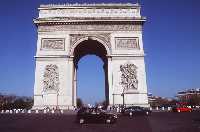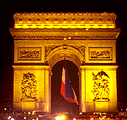"Arc de Triomphe"
 Commissioned in 1806 by Napoleon, shortly after his victory at Austerlitz, it was not finished until 1836. There are four huge relief sculptures at the bases of the four pillars. These commemorate The Triumph of 1810 (Cortot); Resistance , and Peace (both by Etex); and The Departure of the Volunteers, more commonly known by the name La Marseillaise (Rude).
Commissioned in 1806 by Napoleon, shortly after his victory at Austerlitz, it was not finished until 1836. There are four huge relief sculptures at the bases of the four pillars. These commemorate The Triumph of 1810 (Cortot); Resistance , and Peace (both by Etex); and The Departure of the Volunteers, more commonly known by the name La Marseillaise (Rude).  La Marseillaise by François Rude; One of four reliefs on the pillars of the Arch. The day the Battle of Verdun started in 1916, the sword carried by the figure representing the Republic broke off. The relief was immediately hidden to conceal the accident and avoid any undesired associations or interpretations as a bad omen.
La Marseillaise by François Rude; One of four reliefs on the pillars of the Arch. The day the Battle of Verdun started in 1916, the sword carried by the figure representing the Republic broke off. The relief was immediately hidden to conceal the accident and avoid any undesired associations or interpretations as a bad omen. Engraved around the top of the Arch are the names of major victories won during the Revolutionary and Napoleonic periods. The names of less important victories, as well as those of 558 generals, are to found on the inside walls. Generals whose names are underlined died in action
Engraved around the top of the Arch are the names of major victories won during the Revolutionary and Napoleonic periods. The names of less important victories, as well as those of 558 generals, are to found on the inside walls. Generals whose names are underlined died in action
Beneath the Arch is the Tomb of the Unknown Soldier, and eternal flame commemorating the dead of the two world wars. Here every Armistice Day (11 November) the President of the Republic lays a wreath. On 14 July - the French National Day (refered to as Bastille Day everywhere except in France) - a military parade down the Champs Elysées begins here. For important occasions of state, and national holidays, a huge French tricolor is unfurled and hung from the vaulted ceiling inside of the Arch.
Here every Armistice Day (11 November) the President of the Republic lays a wreath. On 14 July - the French National Day (refered to as Bastille Day everywhere except in France) - a military parade down the Champs Elysées begins here. For important occasions of state, and national holidays, a huge French tricolor is unfurled and hung from the vaulted ceiling inside of the Arch.


0 Comments:
Post a Comment
<< Home